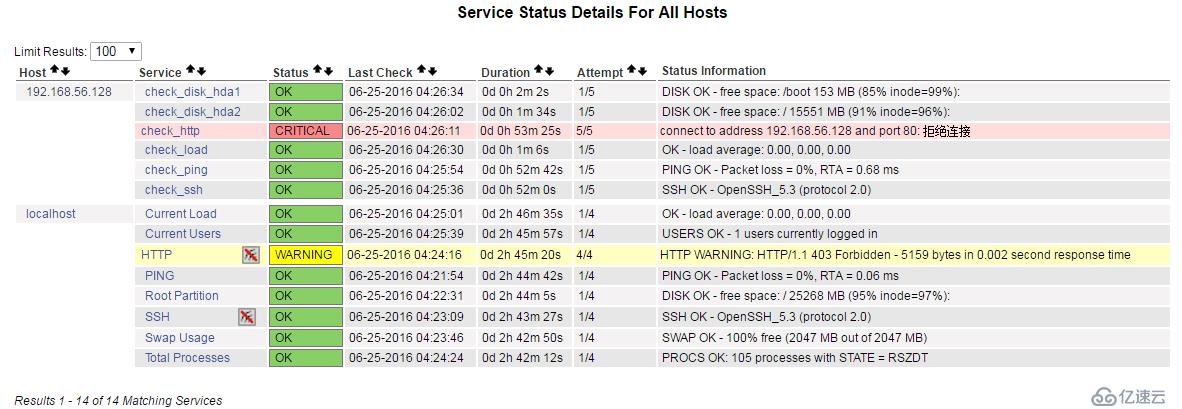配置客户端
安装 epel 扩展源
[root@localhost ~]# yum install -y epel-release安装 nagios 以及 nagios-plugins
[root@localhost ~]# yum install -y nagios-plugins nagios-plugins-all nrpe nagios-plugins-nrpe编辑配置文件
[root@localhost ~]# vim /etc/nagios/nrpe.cfg找到“allowed_hosts=127.0.0.1”改为“allowed_hosts=127.0.0.1,192.168.56.133”后面的ip为服务端ip
找到“dont_blame_nrpe=0”改为“dont_blame_nrpe=1”
allowed_hosts=127.0.0.1,192.168.56.133
dont_blame_nrpe=1启动客户端
[root@localhost ~]# /etc/init.d/nrpe start
Starting nrpe: [确定]
服务端配置:(!!!服务端操作)
客户端ip为192.168.56.128,下面定义子配置文件。
[root@localhost ~]# cd /etc/nagios/conf.d/
[root@localhost conf.d]# vim 192.168.56.128.cfg
define host{
use linux-server
host_name 192.168.56.128
alias 56.128
address 192.168.56.128
}
define service{
use generic-service
host_name 192.168.56.128
service_description check_ping
check_command check_ping!100.0,20%!200.0,50%
max_check_attempts 5
normal_check_interval 1
}
define service{
use generic-service
host_name 192.168.56.128
service_description check_ssh
check_command check_ssh
max_check_attempts 5
normal_check_interval 1
notification_interval 60
}
define service{
use generic-service
host_name 192.168.56.128
service_description check_http
check_command check_http
max_check_attempts 5
normal_check_interval 1
} 说明:“max_check_attempts 5”表示,当nagios检测到问题时,一共尝试检测5次都有问题才会告警,如果该数值为1,那么检测到问题就立即告警。“normal_check_interval 1”表示,重新检测的时间间隔,单位是分钟,默认是3分钟。“notification_interval 60”表示,在服务出现异常后,故障一直没有解决,nagios再次对使用者发出通知的时间,单位是分钟。如果认为所有的事件只需要一次通知就够了,可以把这里的选项设为0。
以上服务不依赖客户端nrpe服务,比如我们在自己电脑上可以使用ping或者telnet探测远程任何一台机器是否存活、是否开启某个端口或服务。而当检测客户端上的某个具体服务的情况时,就需要借助于nrpe了,比如想知道客户端机器的负载或磁盘使用情况。
编辑完配置文件后,在服务端重启一下nagios服务。
[root@localhost conf.d]# service nagios restart
Running configuration check...done.
Stopping nagios: .done.
Starting nagios: done.然后在浏览器中访问nagios,刷新会多出来一个主机,并且多出来三个服务。

只不过这三个服务并不是我们想要的,我想要监控负载和磁盘使用率等服务,这时候就要使用nrpe服务了。继续在服务端添加服务。
(!!!服务端操作)
编辑配置文件
[root@localhost ~]# vim /etc/nagios/objects/commands.cfg增加:
define command{
command_name check_nrpe
command_line $USER1$/check_nrpe -H $HOSTADDRESS$ -c $ARG1$
}继续编辑
[root@localhost ~]# vim /etc/nagios/conf.d/192.168.56.128.cfg
define service{
use generic-service
host_name 192.168.56.128
service_description check_load
check_command check_nrpe!check_load
max_check_attempts 5
normal_check_interval 1
}
define service{
use generic-service
host_name 192.168.56.128
service_description check_disk_hda1
check_command check_nrpe!check_hda1
max_check_attempts 5
normal_check_interval 1
}
define service{
use generic-service
host_name 192.168.56.128
service_description check_disk_hda2
check_command check_nrpe!check_hda2
max_check_attempts 5
normal_check_interval 1
}说明:“check_nrpe!check_load”这里的check_nrpe就是在commands.cfg刚刚定义的,check_load是远程主机上的一个检测脚本。
(!!!以下客户端操作)
在远程主机上编辑 nrpe.cfg 配置文件
[root@localhost ~]# vim /etc/nagios/nrpe.cfg找到 check_load 这一行,这行就是在客户端上要执行的脚本。然后把 check_hda1 更改一下:/dev/hda1 改为 /dev/sda1。再加一行检测sda2的语句。
command[check_load]=/usr/lib64/nagios/plugins/check_load -w 15,10,5 -c 30,25,20
command[check_hda1]=/usr/lib64/nagios/plugins/check_disk -w 20% -c 10% -p /dev/sda1
command[check_hda2]=/usr/lib64/nagios/plugins/check_disk -w 20% -c 10% -p /dev/sda2客户端重启 nrpe 服务
[root@localhost ~]# service nrpe restart
Shutting down nrpe: [确定]
Starting nrpe: [确定]服务端重启 nagios 服务
[root@localhost ~]# service nagios restart
Running configuration check...done.
Stopping nagios: done.
Starting nagios: done.浏览器刷新,又有三个服务出来,稍等一会儿就能看到状态了。


亿速云「云服务器」,即开即用、新一代英特尔至强铂金CPU、三副本存储NVMe SSD云盘,价格低至29元/月。点击查看>>
免责声明:本站发布的内容(图片、视频和文字)以原创、转载和分享为主,文章观点不代表本网站立场,如果涉及侵权请联系站长邮箱:is@yisu.com进行举报,并提供相关证据,一经查实,将立刻删除涉嫌侵权内容。